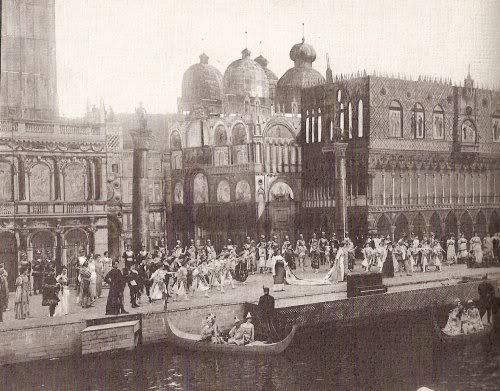All in all, there were over 30 amusements along the Trail. They ranged from "replicas" of exotic locales (Cairo, Siberia, Alaska, Japan) to the carnival (haunted castles, temples of mirth) to the sensational & bizarre (intelligent horses).
My favorite, however, was the Carnival of Venice, produced by the world-famous Bolossy Kiralfy. Kiralfy (and his brother Imre's) expertise was grandoise, spectacular productions, including Jules Vernes' A Trip to the Moon.2 Carnival of Venice was no exception, featuring a 300 member cast performing dance, song & skit on a 400-foot set complete w/ gondalas.

The set & cast of Carnival of Venice.
If the set & size of the cast seems extravagent, keep in mind said cast included European ballerinas & members of the Metropolitan Opera Company.3 This production was not cheap. And, unfortunately, the Carnival of Venice, like the vast majority of the entertainments of the Trail, operated at a loss.4 The Carnival would have closed early if not for the charity of the Exposition's management company, which buoyed the production financially 'til the Expo's close in October.5
-d.d.
1 Although the 1905 Expo was not officially sanctioned such as to designate it a "World's Fair," it remained only event of that nature which occurred that year, making it the 1905 World's Fair by default if nothing else. Or at least that's the story I'm sticking to.
2 In his own words regarding Trip to the Moon, "It dealt with a young prince of the Kingdom of Nowhere. Tired of life on earth, he builds a cannon a mile long so that he can be shot up to the moon. Once there he falls in love with a lunar princess. The story was too farcical, but allowed for unusual ballets. The construction of the massive cannon was a dance production scene set in a foundry."
3 "Complete with serenading gondoliers and scheming lovers who drifted between audience and stage, Bolossy Kiralfy's 400-foot-long set recalled Venice's Grand Canal during the height of the legendary city's gay carnival season. The carnival's 300 members, including a large contingent of European ballerinas and a chorus drawn from the Metropolitan Opera Company, entertained fairgoers with dances, songs and skits." Abbott, Carl. The Great Extravaganza; Portland & the Lewis & Clark Exposition. Oregon Historical Society. Portland, Oregon. 1981. p. 48.
4 The exceptions being, possibly, the Siberia et al. stuff.
5 "Though vistors had to pass along The Trail to reach the federal buildings, they apparently saved thier money for 10cent vaudeville shows downtown or unmentionable pleasures in Chinatown. The elaborate Carnival of Venice, for one example, would have closed its doors and beached its gondolas without the quiet assistance from the Exposition management." Abbott, p. 64

